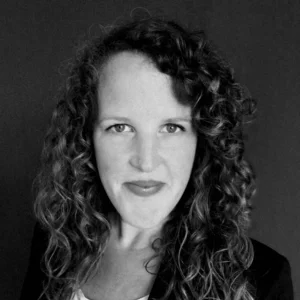Responsibility and Possibilities of the Independent Performing Arts in the Era of AI
Lecture at the "Transformations of the theatrical landscape" symposium
Dr. Hilke Marit Berger. CityScienceLab/HafenCity Universität Hamburg
Exposé
This study shows a variety of artistic possibilities that, when viewed together, have potential in several respects. On the one hand, there is the development of new formats, narrative techniques, formal languages and approaches. On the other hand, there is the visualization of the systematics and modes of action of a technology that, beginning with its name, has been so mystified that the vast majority of people believe themselves passively at the mercy of a technological progress that we are all in fact very actively driving forward.
The corresponding consequences, such as the radicalization of racial stereotyping, norming, surveillance and influence, have long been felt and will increase further in the future. The funding of AI in the performing arts cannot be thought of separately from the transformation of a digital theater culture or the promotion of theatrical digitality in our post-digital society. Instead of ignoring technological possibilities, there needs to be an active and thus formative engagement with these processes, in accordance with the self-image of a progressive art form that wants to have social relevance. The greatest potential of artistic-technical work lies in the possibility of making these technologies visible and communicating them, also when it comes to developing alternative practices and possibilities of use. Artists can only assume the formative responsibility that is evident in this if there are framework conditions that make productive work possible. The responsibility for enabling this potential of artistic practice thus also lies with the funding institutions, cooperating partners and networks. This requires all participants to show courage and the willingness to engage in new formats and experiments (including when it comes to funding).
The working method is only conceivable as an interconnection of art, technology, and science, because the vast majority of projects are also to be seen as artistic research. The established separation between art and technology is a hurdle that must be overcome in this field, as is persistence in the stiff corset of divisional and silo thinking. Working in inter- and transdisciplinary teams, at new interfaces (e.g., in the virtual) and hybrid formats, is an important further development, both within the scene and when it comes to networking with other social areas, competencies and institutions. The working basis for this is always the development of a common language, which is at the same time one of the greatest challenges and therefore also takes time.
In order to be able to draw on existing knowledge, investments should be made not only in projects, but above all in structures and networks. This requires a new cultural practice of sharing (of experiential knowledge, technologies and results) in the performing arts scene, which must become a matter of course in a similar way as it is in the technological field. The prerequisite for this is the possibility of being allowed to further develop what already exists and not having to start anew with every project. Instead of innovation, the focus should be on constructive development!
The essential factors for successful funding are the provision of more time, the acceptance of other formats and experiments, and the allowance of free spaces in which failure can also be an option. A modular funding that builds on one another, that funds and promotes hybrid formats and the collaboration of very different actors, would be ideal here.
All of these factors could be applied to the fundamental promotion of a new digital culture as an important driver for essential social transformation processes. For this reason, art should be anchored as a supporting level in the federal program for digitality, exemplified by the AUTONOM program, which is firmly anchored in the federal government's AI strategy. Because: Taking on creative responsibility is not a privilege of art, but a simple social necessity.
Involved
-
Dr. Hilke Marit Berger
CityScienceLab/HafenCity University Hamburg
 © Elisa Braun
© Elisa Braun
Dr. Hilke Marit Berger
CityScienceLab/HafenCity University HamburgHilke Marit Berger is an urban researcher working at the interface of cultural studies and urban planning on the connection between technical issues and social as well as cultural developments. Her research interests include practices of participation, co-creation and collective urban design in the field of artistic practice and politics. In her current transdisciplinary research, she investigates the collaborative potential of mixed reality applications (especially VR and AR) for participation processes in urban planning. She serves as a juror in various contexts and advisory boards, developed, coordinated and worked for several artistic and scientific projects, for festivals, theaters, universities and authorities in Leipzig, Berlin and Hamburg. She lectures and publishes internationally. Currently she is a researcher at the CityScienceLab of the HafenCity University Hamburg (a cooperation with the Media Lab of MIT Cambridge / USA) and is responsible for the research program.